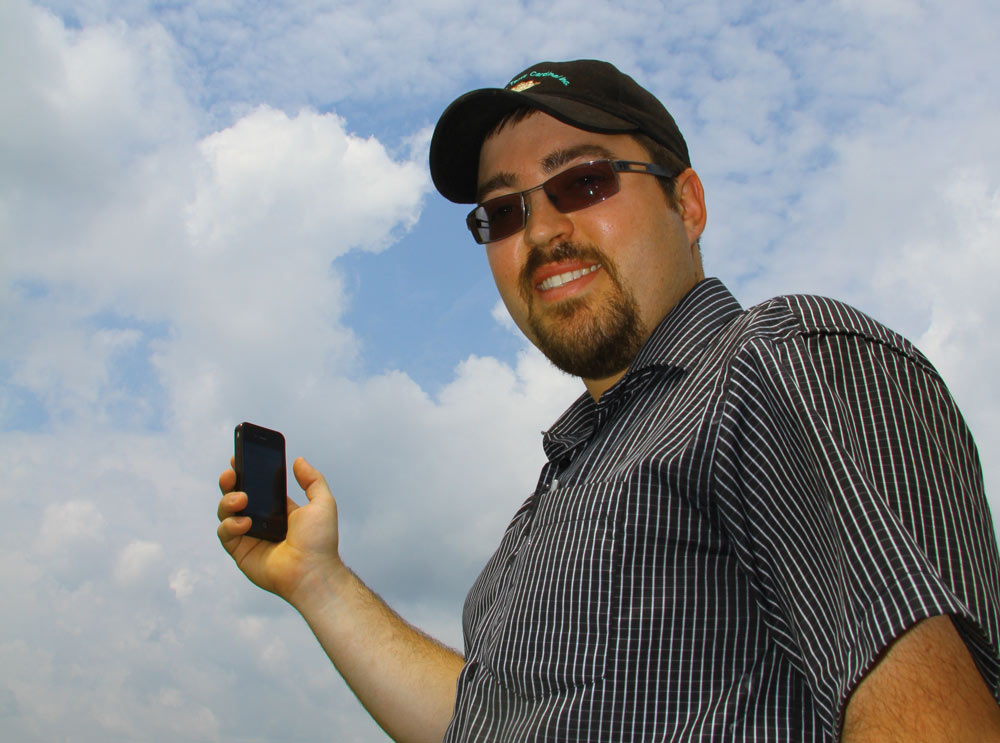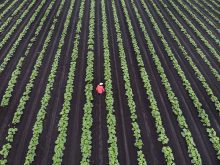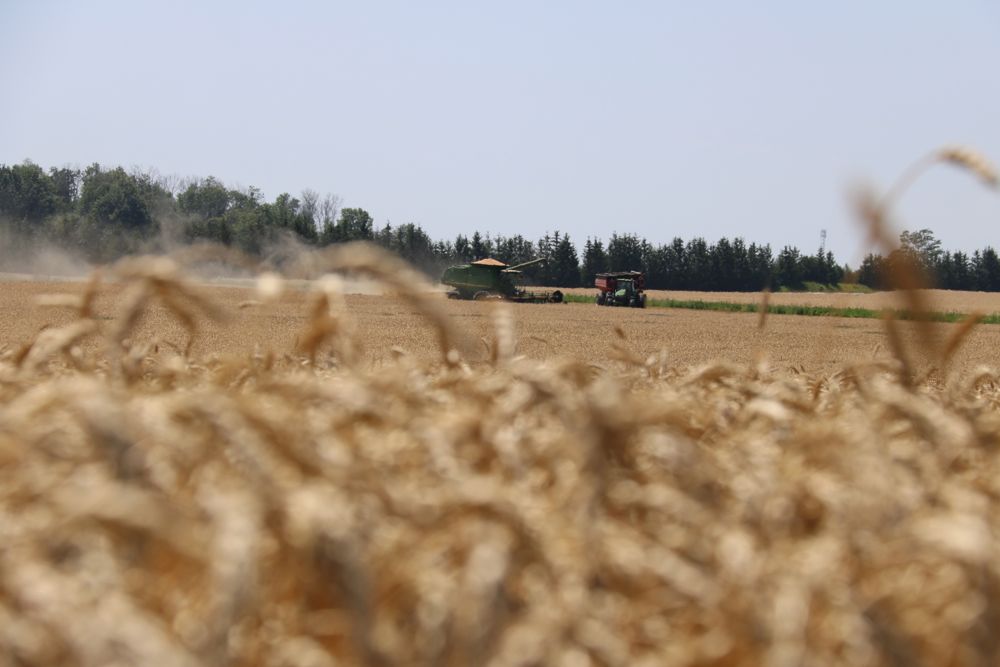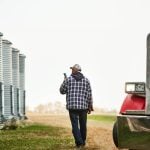At Maxime Cardinal’s potato farm, there are more than 120 fields, some of them with more than one variety. From the first pass working the soil in the spring through to harvest, machinery will enter any given field up to 15 times. That’s a lot of information to keep track of!
Cardinal, his father, Yvon and his uncle Claude rely entirely on clouds to water their 1,000 acres of potatoes. Since last spring, they also rely on another type of cloud to help them manage the immense quantity of farming information their operation generates.
Read Also

Could crop sharing be a viable option for your farm?
Crop sharing could be a good option for young and beginning farmers.
At Patates Cardinal, located in Sainte-Brigitte-des-Saults, halfway between Montreal and Quebec City, cloud farming is no longer just a concept. When the sun rises every morning, each worker receives their unique to-do list on their iPhone.
Field number, what to spray and what to watch for are all clearly indicated. When a job is done, the worker checks it off, perhaps adding a few extra observations. Then, after pressing “synchronize,” off they go to the next field.
There’s no notepad whose pages are crumpled or smudged by the rain, and there are no unreadable handwritten notes.
“The information lands in the cloud,” Cardinal says. “In my office, I just have to synchronize the data to obtain an instant update on what has been accomplished out in the field. It’s really easy.”
In this case, the cloud is a server at Farm Credit Canada (FCC). Farm data is safely stored in real time, creating a computer backup that is always up to date. But the cloud has a much deeper purpose, allowing instant information sharing between farmers, employees, consultants and anybody else involved in the farm’s success.
“I can take a photo of a problem in a field and share it instantly with a crop input supplier,” Cardinal says. The picture will be automatically geo-referenced. Should a rep want to come and see for themselves, Cardinal won’t have to bother showing them where to go.
Cloud of the future
The buzz about cloud farming isn’t new, but the truth is that in Canada and in the rest of the world, cloud farming is still in its infancy.
Julien Deslauriers, a sales representative at seed and fertilizer dealer William-Houde, sees a lot of possibilities on the horizon. “If Cardinal asked me to check his cornfields, I could simply access his farm plan on my tablet to know where every cornfield is located. If he’s too busy to accompany me, I could add my observations directly in his electronic field notes.”
Cloud farming will go much further. In fact, it is about to revolutionize the relationship between farmers and those who provide them with professional service and advice.
From the Canadian Cattlemen website: iCalve, a new app for your iPhone
At Logiag, the firm that developed the mobile app and the geomatics for FCC’s Field Manager PRO 360 software, co-owner Gilles Clément is now talking about “tele-agronomy.”
“An agronomist could be examining a photo or a geo-referenced note of an observation made in the field and decide to give a recommendation without leaving their desk,” Clément says. He believes having complete and instant access to a field’s history on a tablet or desktop computer could actually be more useful than standing in a field looking at a poor crop.
Clément’s partner at Logiag, agronomist Jacques Nault, foresees a closer relationship between the farmer and the farm’s consultants.
“Communication will be more fluid, more interactive and more efficient, because the consultant will always know exactly what has been going on in a field,” Nault says. Because cloud farming translates into better record-keeping, therefore, consultants will be able to base their recommendations on better-quality information.
“It will always be useful to go out to the field,” Nault says. “But it’s not by walking a field that you obtain the best data for troubleshooting. The analysis will be better by using a computer screen to look at precise data about soil type, micro-topography, fertility and the complete history of operations conducted in that field.”
Paperless management
Cardinal remembers his farm’s first attempt at mobile data management using pocket PCs. “We had to bring them back to the office to synchronize the data,” he says. “Often, employees would forget them in the tractor, the battery would die and the data would get lost.”
Handwritten notes were always useful, but sometimes they were hard to read and understand, and at the end of each day, someone had to enter the data in a computer. Often, the information would remain incomplete.
With smartphones, everything is easier. At Patates Cardinal, everyone already had an iPhone. Because employees also rely on them for personal use, the phones are always charged. Checkmarking a completed task is easy, especially in tractors with automated steering. Information from field operations is complete, precise and almost instantly accessible on the farm’s main computer or through a faraway server.
As a crop input sales rep, Deslauriers must collect information from each of his clients in order for staff agronomists at William-Houde to complete their fertility planning. Busy clients may not remember very accurately where, when and exactly how much manure they have spread, he says. “If everything was noted systematically during the season, there would be a lot fewer mistakes and oversights. The producer would simply have to authorize me to access the information relevant to their fertility plan.”
The data managed with the Field Manager PRO 360 software can encompass a wide range of aspects of farm management, including field records, grain marketing, production costs, financial analysis and more.
“The data always belongs to the farmer. They’re the ones who grant access rights, with user names and passwords,” says FCC’s management software specialist Matthew Van Dijk. For example, a seed supplier could only have access to the data regarding the fields where their products were used.
Soon, farm equipment will take part in collecting data and sending it off to the cloud. “I believe this will be the next step. Yield monitors and other devices (on planters and sprayers) will also instantly share the data they collect,” Van Dijk says. For now, the information generated by most of these devices must be transferred to farm management software using a USB key or an SD memory card.
Manufacturers like John Deere and Case have already embraced cloud farming. The technology is ready, but has yet to be fully deployed and promoted. With JDLink, for example, a tractor uses cellphone or satellite signal to communicate engine performance data (mechanical problems, fuel consumption, location) to a server. Alerts can be sent should the tractor be started in the middle of the night or driven outside of a set perimeter.
“All precision farming monitors will soon transfer their data through wireless signal. The farmer will be able to access and share the data using the MyJohnDeere.com website,” says John Deere spokesperson Rémi Bourgault. The website is already up and running and selected farmers all across North America are testing it.
To those worrying about poor wireless signal in their fields, Bourgault explains that transmitters installed on tractors and other equipment are more powerful than those inside our cellphones. Because the signal contains raw data rather than voice, the transfer may be interrupted for a few seconds and resumed without loss of data.
At Patates Cardinal, the next step will be to start using Field Manager PRO 360’s geomatics module. Specific colours can be assigned to a seed variety, a pesticide dose, or a yield level in order to create instant maps of what is happening in each field.
Cardinal would also like to match data from his own weather station and from regional weather stations to each field operation. Sooner or later, cloud farming will make this possible, Clément says.
Even on small farms, the quantity of information exceeds the limits of human memory. Spending around $1,200 for the software and mobile application may look like a lot. But better, more complete records that don’t require hours of data entry at the farm’s desktop computer may actually translate into time and money savings.
Some older farmers may never embrace cloud farming, Deslauriers says. “But for the younger generation, these tools are very easy to use. Everyone is now using a smartphone.”
“I had been waiting for this technology,” Cardinal says. “I started using it as soon as it came along.”















